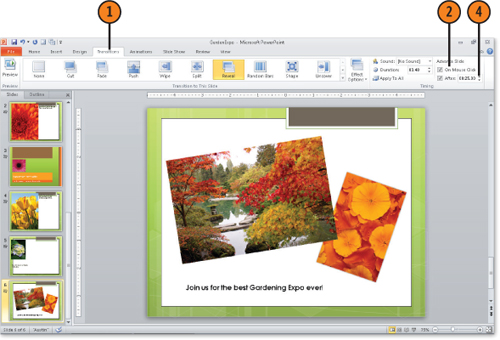You can advance from slide to slide in a presentation
in several ways, such as by clicking your mouse or by waiting for a
certain interval of time to pass. The manual approach of clicking your
mouse gives you control, but it keeps your hands busy during the
presentation. The automatic timed-advance feature is useful when you are
showing a slide show on the Web or in an unattended setting, such as a
mall kiosk. If you need to have a combination of methods within a
presentation, you can make this setting on a slide-by-slide basis by
using tools on the Animations tab.
Select a Method to Advance a Slide
Display a slide with a transition applied to it. Click the Transitions tab.
If you want to advance slides manually, click the On Mouse Click check box to select it.
Clear the On Mouse Click check box to advance the slide according to preset timings.
Use the spinner arrows in the After field to set a time interval.

Note:
You can also use the Right
arrow key to advance a presentation, if you have the keyboard handy, or
click the Slide tool that appears in Slide Show view and choose Next or
Previous from the pop-up menu. Many presentation settings also make a
remote control unit available that you can use for forwarding slides.
Note:
You can set up your show so that all slides are advanced using the same method.